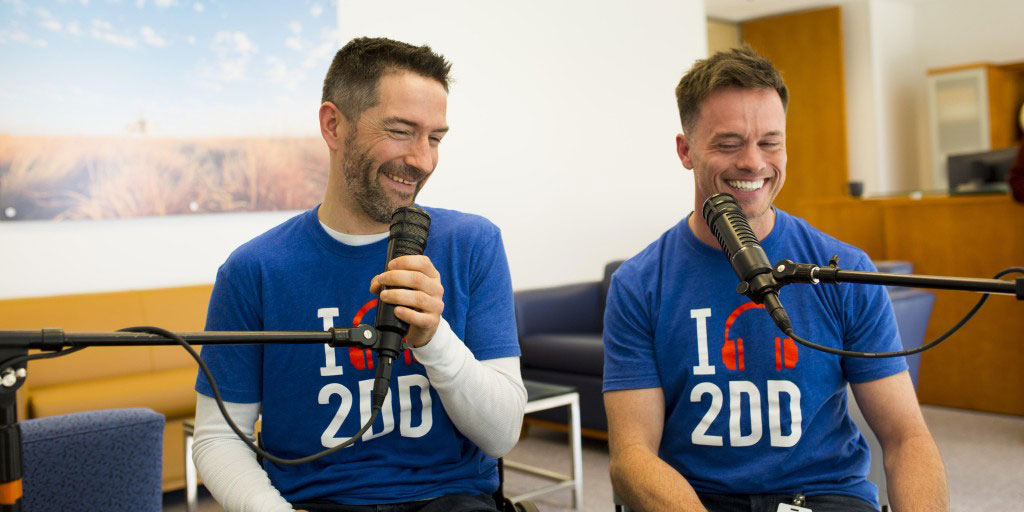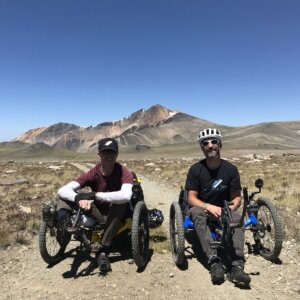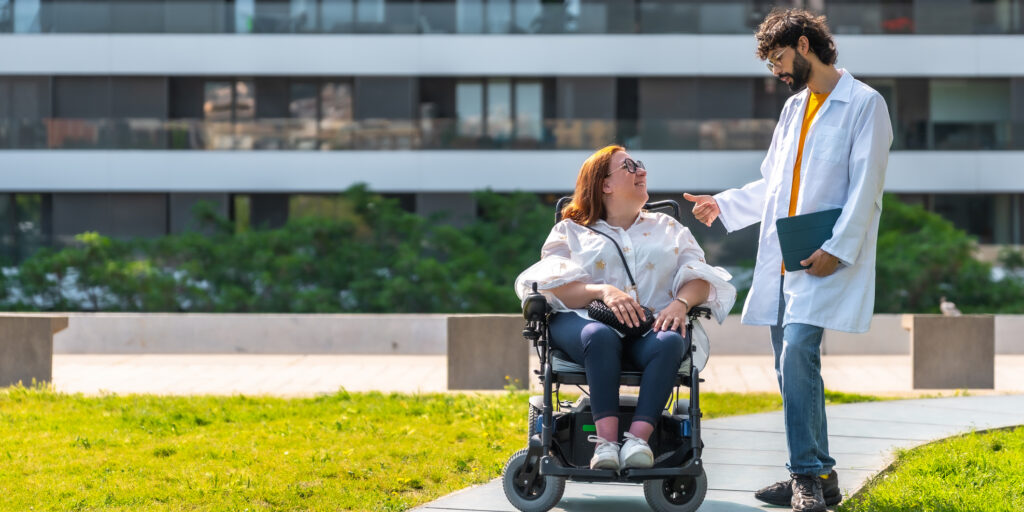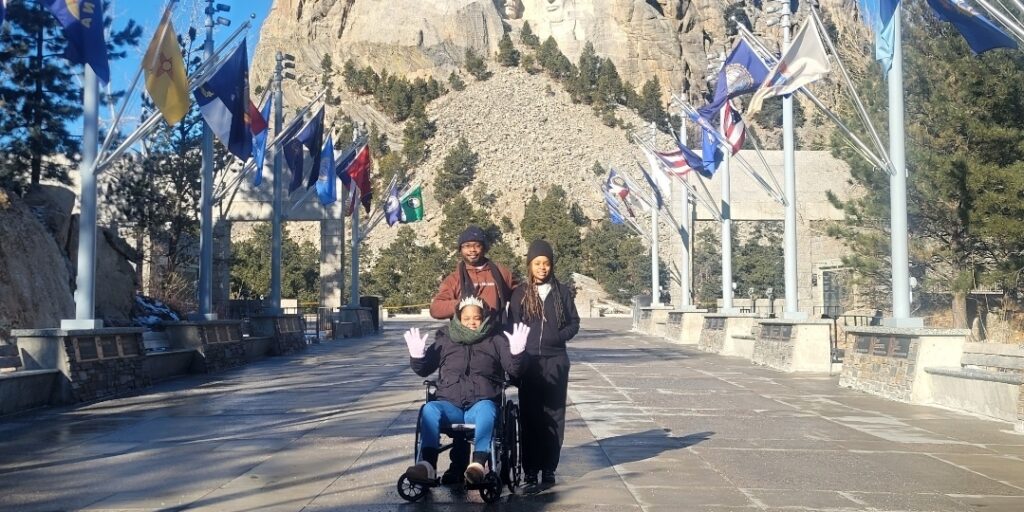
Two Dudes, One Goal: Podcast Hosts Kyle Bryant and Sean Baumstark Envision (Then Live) Life Beyond Circumstances
By Lindsey Baker | Tuesday, September 22, 2020
Sean Baumstark was 25 when he was diagnosed with Friedrich’s ataxia, a neuromuscular disease that affects the nervous system and heart and causes muscle weakness and ataxia, a loss of balance and coordination.
“During my diagnosis,” Sean says, “the geneticist started talking about support groups and encouraging that I come to grips with what I was up against. And in that moment, although I believe in support groups and I certainly don’t take things for granted, in that season of my life, I simply said, ‘Thank you, let’s move the conversation on’ because I didn’t see a need for that in that moment. I realized that, sure, down the road that might be necessary. But in that moment, that didn’t connect with me.”
But Sean still wanted to learn about FA, any research being done toward finding treatments. He did want to know he wasn’t — as he felt — the only one out there.
That’s when he found Kyle Bryant’s name.
“I left that appointment,” Sean says, “and that night I was online, and it was in that searching that I found Kyle’s name. He was mentioned a lot in my local news. I thought, ‘Why is my local news talking about this guy?’”
Kyle, who also has FA, lived in the same city as Sean. He’d completed a cross-country bike ride a few months prior to Sean’s search. Same age, same diagnosis.
“I thought, ‘OK, this guy’s my new best friend,’ Sean says. “I gotta figure out what this is all about, what we’re gonna do about it. We’ve got a mountain to climb here. Let’s do it.”
So he hunted down Kyle’s contact information. The two agreed to meet for lunch. And that lunch turned into a friendship — and a podcast — that now spans coast to coast. On Two Disabled Dudes, Sean and Kyle talk to each other, and with guests living and working in the neuromuscular disease community, about, as they put it, “setting sights beyond the challenges in life and dreaming big, making a plan, and then executing like mad.” The conversation often gets personal — sometimes, Sean and Kyle discover new things about each other, and themselves, in the course of an episode.
As Two Disabled Dudes enters its fourth season, the dudes sat down to talk about how FA affects their lives — and helps to create some of those big dreams.
Could you both share a little bit about each of your journeys with FA?
Kyle: I was diagnosed when I was 17. Sean and I are both 38 right now. So, I was 17, and it came out of the blue. The first thing [for my family to do] was find out as much as we could. And we found out some things were not very positive. So we were like, “All right, if that’s gonna be the future, then we better get to livin’.” It took almost 10 years, but I figured out I wanted to do a cross-country bike ride from San Diego to Memphis. In 2007, my dad rode with me, and my mom drove our support vehicle. And we stayed together every single night for 58 days. And you would think — like, we’re family — you would think there would be some conflicts, but they quickly got squashed because we were so focused on the end goal, on improving our lives, proving to ourselves that we can make an impact in the world, and hopefully helping other people.
We did two more bike rides the next two years. In 2009, I came on staff at the Friedreich’s Ataxia Research Alliance, and we began to build a series of bike rides all around the country. And then in 2010, we put together a team for the World’s Toughest Bike Race, a race from San Diego to Annapolis, Md. That was one of the huge projects Sean and I worked together. We were both on that team.
Sean: My personal journey backs way up. I was 25 when I was diagnosed, so much later onset than most. And unlike Kyle, what kind of pushed me to the doctor was fatigue. FA is just an energy-depriving sort of condition. The diagnosis certainly provided answers to a lot of things, especially why I was tired all the time and why I couldn’t walk a straight line. I would bump into walls or people. That diagnosis certainly helped put a few things in perspective.
Shortly after that, Kyle and I met, and that’s when we began to put our heads together and do things, like riding. Like Kyle said, if we’re going to be limited to a chair or even die young, then we have a lot of work to do in a very short period of time. Throughout the years, that’s really what helped us build a friendship and a commitment to doing whatever we could along the way, in spite of the limitations that our disease said we should be experiencing or that we will experience someday.
How do your diagnoses affect your life day to day?
Sean: I work for a small grocery retailer in Northern California. We have 15 stores, and I help with the onboarding orientation process of all of our new hires. The job itself, or the condition of FA, can be challenging, in that it’s hard to walk. Can’t really run fast. I can’t do anything fast. I can’t talk fast. I have a hard time writing or doing anything with any type of intentional control. It can be very exhausting trying to focus on the day-to-day activities of my job. And not that my job is hard or challenging, but just, that’s the major part of what I do every day, so that’s the context I’m speaking in.
“I don’t think I’m any different than someone who’s able-bodied. We get to the same things in life in different ways.”
It has definitely caused me to carefully plan ahead. I’ve got to plan my rest schedule every week so that I’m refreshed every day that I go to work and able to perform the duties of my job.
Kyle: For me, day to day, I think that somebody who’s able-bodied and doesn’t know the world of disability, they would be like, “Dude, you’re so limited.” But I certainly do not think of it that way. Like, OK, fine, I have a grab bar next to my toilet, and I use a wheelchair. But I don’t think every time I use the grab bar, “I wish I didn’t have to use this thing.” It’s a tool that I personally need. I am different from everyone else, just like everyone is different from each other, and I need these tools to get done the things that I want to do. I drive with hand controls. I ride a trike with three wheels instead of a bike, but I can outride … not everyone I know, but I feel pretty powerful on my trike.
Like Sean, I have a full-time job. And people are counting on me to be there, and it feels good to be counted on, right? Maybe that’s a lot of what work is, you know? We’re needed, and so I don’t think that … at a fundamental level, I don’t think I’m any different than someone who’s able-bodied. We get to the same things in life in different ways. And, you know, we all want and need certain things out of life, and it’s just a matter of figuring out how to get there.
Did you know anybody else with FA before you met each other?
Kyle: I had met other people with FA, but I had never met anyone who was thinking the way Sean does, thinking big and thinking about what we could do with FA. When Sean and I sat down for lunch the first time, we were talking about the potential of our situation, not how much of a deficit we’re at compared to other people. And I think that was one of the big reasons that we’re still friends and doing things together, because we try and think big about possibilities.
Sean: When I reached out to Kyle, it was definitely a matter of, “Hey, tell me what I’m up against, what you’re experiencing,” but also, “let’s talk about what we can do.” And it was our first meeting where he talked a little bit about the bike ride that he had just done with his parents. And then we decided to meet up again about two weeks later, and it was in that meeting that Kyle was talking about doing another bike ride. And I said, “I’m in. What do I need to do?”
There are moments where, sure, I wish things were different. I wish I was faster. I wish I could run. But at the end of the day, that’s just me coming to terms with it and me grieving the life I used to hope for. That is not me being ruled by that grief or ruled by that devastation or ruled by that disappointment. That’s just a part of that process. I definitely believe there’s a lot of life to be lived, and I’m happy to live it. I’ve got work to do.
How did you guys decide to start the podcast?
Sean: That was all Kyle.
Kyle: So when we did Race Across America together from San Diego to Annapolis, there was a documentary crew with us the entire time, and they made a really great documentary. Sean has a few really great monologues in the film, just talking about life and things he cares about and why this is impacting him so heavily, and I was like, “You know what? We need to talk about that stuff all the time. Let’s record it, and other people might find value in it as well.”

Sean: You know, not to pat ourselves on the back, but one thing I loved about even just the way he put it — “Hey, I have an idea. Let’s do a podcast.” And the response was, “OK, let’s do it.” When we did a ride, I didn’t own a bike. When we started a podcast, neither one of us had any clue where to start, what to do, or how to do it. We’re on opposite sides of the country now. I’m in California. He’s in Pennsylvania. But I think a testament of Kyle’s and many others is, OK, sure, there’s gonna be a challenge, but the overall message needs to be explored so let’s just figure out those challenges and find a way to make it happen. And even though we didn’t know what we were doing, here we are almost four years later, and we’ve got a pretty strong following that we are certainly proud of.
How does the podcast come together with you guys in such different time zones? How do you choose the topics and bring it together?
Sean: Originally, once Kyle and I decided to move forward, we had reached out to a friend of ours, also with FA, who had a career in audio production for concerts, to help us with editing. Kyle and I will talk to each other via Zoom or Skype or some sort of live platform. And individually, we’ll record our own tracks. Then we put those two tracks together, and hopefully it sounds just as fluid for our listeners as it does for us. Currently, our editing is mostly just Kyle and I.
Kyle: The topics are really whatever Sean and I are thinking about and what happens in our lives. Maybe there’s some topics that are coming to the forefront for us lately. We also interview some really incredible people, and that has turned into a source of great conversation. Sometimes, we just sit down and turn on the mikes and go.
Sean: I think to speak to that, one of my favorite episodes is No. 114. Kyle had a story to share that he hadn’t shared with me before, so we knew that there would be an organic conversation, maybe five to 10 minutes. I think we both kind of expected to share this story, maybe rant and rave a little bit, and move on. But in that moment, it turned into a 25- or 30-minute conversation that I think challenged both of us to rethink how we approach our own lives or how we approach strangers. And it’s that willingness and flexibility to be vulnerable, even though we’re being recorded.
Why is vulnerability important? What’s the benefit of learning how to be vulnerable in conversation?
Kyle: I feel like the value of vulnerability is super fundamental because what are we doing here if we’re just gonna be fake? It’s up to us to put our real selves out there, with all our flaws, or else we’re putting on a show that’s not even who we are. Sometimes we get to a very vulnerable place in our podcasts, and I value it personally because it’s an outlet where I can feel comfortable being vulnerable. Holy cow, that’s kind of a weird concept. You know, all these people are listening to our conversation, but between me and Sean, we feel comfortable having a vulnerable conversation. And it makes me feel good to have that outlet, because I don’t always feel comfortable sharing my full self.
Sean: I think, too, to add to that, vulnerability is where other people, whether they know us or not, connect with us or connect with a message of hope. When we pass by the magazine rack at the grocery store or we’re scrolling Instagram, it’s easy to think everybody else has their lives figured out. But I think we all know that no matter who they are, what their celebrity or financial status is, everybody’s got bad days. Everybody’s got hardships. And when you’re willing to talk openly and be vulnerable in a space that allows that, I think that’s what allows people to connect with you and the overall message. And it allows them to take some ownership over the hard stuff in their life and gives them a little bit of hope that, OK, although this is hard, it’s not the end of the world.
If Kyle wouldn’t have been willing to meet me or would have been willing to be honest and vulnerable, what would the last 10 years have looked like for me? Or for him? Or for us together? Or for the podcast? Or for the film that we’re a part of? All these different things probably wouldn’t have come to pass, which means we wouldn’t have met people all over the world.
Why is it important to talk about rare diseases and our experiences?
Sean: Because it’s rare disease, it’s easy, and I think even automatic, to feel alone, to feel like you’re the only person who understands, who knows this, who is dealing with it. But I also think that’s true in the world of pain. My dad fought cancer for five years before he passed away. There were plenty of moments where he felt like he was the only one in the world up against the mountains he was up against. And whether you’re talking rare disease or something more common, it’s in those moments of talking about it and connecting with others that you realize you’re not by yourself, that there are other people in your corner, that there are other people who are cheering you on. There are other people willing to cry with you and laugh with you and plenty of other people that are also willing to triumph with you and celebrate the wins, big or small.
What do you hope listeners get from the podcast?
Kyle: The way I think of it is, like, OK, there’s a 17-year-old boy and he was diagnosed with FA, Charcot-Marie-Tooth disease, any of these things, and he’s nervous to talk about it with his parents, with his friends, with his teachers, everyone. But he can go in his room, put on his headphones, and relate to somebody with a rare disease in his own world, in his own mind. And if he can be a fly on the wall for a vulnerable conversation that Sean and I are having, maybe that’s valuable.
Sean: Yeah. I would second that.
Check out the Two Disabled Dudes podcast on Apple Podcasts, Stitcher, Spotify, or wherever you listen to podcasts. The dudes’ are especially excited about episode 118 of the new season, featuring Google’s Project Euphonia, designed to retrain smart devices to understand people with different ways of speaking.
Disclaimer: No content on this site should ever be used as a substitute for direct medical advice from your doctor or other qualified clinician.




